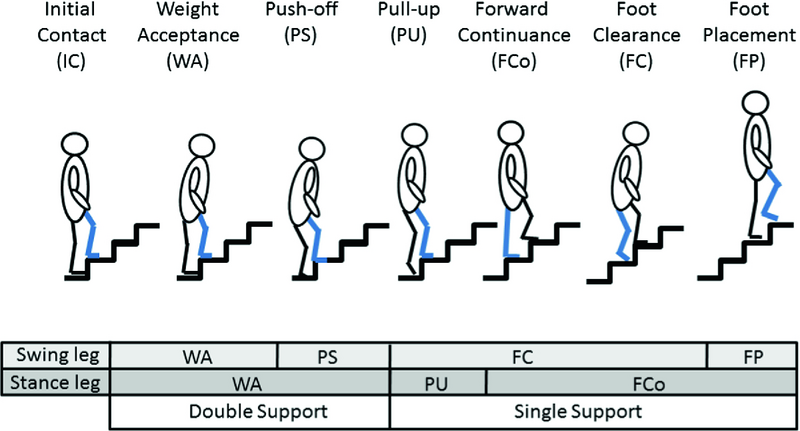Stair Gait
Original Editor - User Name
Top Contributors - Rishika Babburu, Lucinda hampton and Kim Jackson
This article or area is currently under construction and may only be partially complete. Please come back soon to see the finished work! (25/01/2022)
Introduction[edit | edit source]
A fundamental body movement is required to ascend and descend stairs. It is important for everyday activities such as shopping, taking public transportation, or going about a multistory building or apartment. The variation between the two modes of locomotion(level-ground locomotion and stair locomotion) may be significant for a patient population.If a patient has adequate muscle strength and joint ROM for level-ground walking, it does not ensure that the patient will be able to walk up and down stairs.
Biomechanics[edit | edit source]
Locomotion in the stair gait involves both swing and stance phases in which forward progression of the body is brought about by alternating movements of the lower extremities. The lower extremities must balance and carry along HAT(Head, arms and trunk), similar to level ground gait. There is a relationship between the BMI of the subject and also the respective loads at each of the joints.[1]The knee extensor moment in both stair ascent and descent was nearly three times greater than that of level ground walking. The ankle moments are almost similar in both gaits. The knee has generative role in stair ascent( absorptive in level walking). Powers are mostly generative in stair ascent and absorptive in descent for all joints.
The stair gait cycle is divided into:
A.Stance phase and
B.Swing phase.
- Stance phase is subdivided into
- Weight Acceptance
- Pull up
- Forward Continuance
- Swing Phase is subdivided into
- Foot Clearance
- Foot Placement
Vast amount of positive work is involved in stair ascent that is accomplished mainly through concentric action of the rectus femoris, vastus lateralis, soleus, and medial gastrocnemius muscles.
Sagittal Plane Analysis of Stair Ascent:
Stance Phase–Weight Acceptance (0%–14% of Stance Phase) Through Pull-Up (14%–32% of Stance Phase)
Hip Joint - Extension: 60° - 30° of flexion - Gluteus Maximus, Semitendinosus, Gluteus Medius
Knee Joint - Extension: 80°–35° of flexion - Vastus lateralis, Rectus femoris
Ankle Joint - Dorsiflexion: 20°–25° of dorsiflexion, Plantarflexion: 25°–15° of dorsiflexion - Tibialis anterior , Soleus, Gastrocnemius
Stance Phase–Pull-Up (End of Pull-Up) Through Forward Continuance (32%–64% of the Stance Phase of Gait Cycle)
Hip Joint - Extension: 30°–5° flexion,Flexion: 5° to 10°–20° of flexion - Gluteus maximus ,Gluteus medius,Semitendinosus.
Knee Joint - Extension: 35°–10° of flexion,Flexion: 5° to 10°–20° of flexion - Vastus lateralis, Rectus femoris.
Ankle Joint - Plantarflexion: 15° of dorsiflexion to 15°–10° of plantarflexion - Soleus,Gastrocnemius,Tibialis anterior
Swing Phase (64%–100% of Gait Cycle)—Foot Clearance Through Foot Placement
Hip Joint - Flexion: 10°–20° to 40°–60° of flexion, Extension: 40°–60° of flexion to 50° of flexion - Gluteus medius
Knee Joint - Flexion: 10° of flexion to 90°–100° of flexion, Extension: 90°–100° of flexion to 85° of flexion - Vastus lateralis, Semitendinosus, Rectus femoris
Ankle Joint - Dorsiflexion: 10° of plantarflexion to 20° of dorsiflexion - Tibialis anterior.[2]
Descending stairs involves energy absorption and is achieved through eccentric activity of the same muscles.The support moments during stair ascent, stair descent, and level-ground walking show near to same patterns but the magnitude of the moments is greater in stair gait. Hence, more muscle strength is required during stair gait.
References[edit | edit source]
- ↑ https://reader.elsevier.com/reader/sd/pii/S1877050914015099?token=AF8C3E831631772F24F19007FF2B32697087C50469649F80B81FA8B2C79E5E0C3059D3857E4EB3790D8D8C17659F4770&originRegion=eu-west-1&originCreation=20220122114918
- ↑ Pamela K. Levangie, Cynthia C. Norkin,editors. Joint structure and function : A Comprehensive Analysis. 5th Edition. Philadelphia.F. A. Davis Company,2011. p 553,554,555
- ↑ Biomechanical analysis of height and knee flexion in walking stairs. Available from : https://www.youtube.com/watch?v=FRdK2kO80A8







